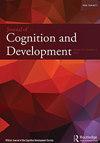儿童定向言语中的概念层次:隐含暗示更可靠
IF 1.6
2区 心理学
Q3 PSYCHOLOGY, DEVELOPMENTAL
引用次数: 0
摘要
摘要为了让孩子们像成年人一样理解和推理世界,他们需要学习概念类别是以分层的方式组织的(例如,狗也是动物)。当孩子们从他们对世界的第一手观察中学习时,通过语言传递社会知识也可以在这种学习中发挥重要作用。先前的研究记录了父母谈话中的一些线索,这些线索可以帮助孩子了解概念层次。然而,这些研究使用了不同的数据集和方法,这使得很难将各种语言线索与概念知识的相对有用性进行比较,也很难测试它们是否能扩展到自然语言。在这里,我们研究了北美和英国收集的大规模英语儿童定向语音语料库,并使用了一种统一的基于分类的评估方法,使我们能够调查和比较根据其提供的信息的明确程度而变化的线索。我们发现,在儿童定向语音中,更明确的线索过于稀疏或过于嘈杂,这使得他们不太可能支持稳健的学习。相反,隐含的线索提供了更可靠的信息来源。此外,我们调查了3至6岁的发育变化,我们发现这些线索在输入中的可用性没有差异。我们的工作证实了照顾者谈话在传达概念信息和支持早期分类学知识发展方面的效用。它为建立一个将基于感知和语言的机制相结合的认知模型迈出了第一步,从而对儿童的概念发展进行更全面的描述。本文章由计算机程序翻译,如有差异,请以英文原文为准。
Conceptual Hierarchy in Child-Directed Speech: Implicit Cues are More Reliable
ABSTRACT In order for children to understand and reason about the world in an adult-like fashion, they need to learn that conceptual categories are organized in a hierarchical fashion (e.g., a dog is also an animal). While children learn from their first-hand observation of the world, social knowledge transmission via language can also play an important role in this learning. Previous studies have documented several cues in parental talk that can help children learn about conceptual hierarchy. However, these studies have used different datasets and methods that have made it difficult to compare the relative usefulness of various linguistic cues to conceptual knowledge and to test whether they scale up to naturalistic speech. Here, we study a large-scale corpus of English child-directed speech – collected in North America and the UK – and used a unified classification-based evaluation method which allowed us to investigate and compare cues that vary in terms of how explicit the information they offer is. We found the more explicit cues to be too sparse or too noisy in child-directed speech, making them unlikely to support robust learning. In contrast, the implicit cues offered a more reliable source of information. Further, we investigated developmental changes from 3 to 6 years of age, and we found no differences in the availability of these cues in the input. Our work confirms the utility of caregiver talk for conveying conceptual information and supporting the development of early taxonomic knowledge. It provides a first step toward a cognitive model that would combine perceptual- and language-based mechanisms, leading to a more comprehensive account of children’s conceptual development.
求助全文
通过发布文献求助,成功后即可免费获取论文全文。
去求助
来源期刊

Journal of Cognition and Development
Multiple-
CiteScore
4.00
自引率
0.00%
发文量
29
期刊介绍:
The Journal of Cognition and Development is the official journal of the Cognitive Development Society (CDS). Some CDS members are concerned with basic research or theory; others focus on policy issues and practical applications. The range of interests includes cognitive development during all stages of life, and we seek to understand ontogenetic processes in both humans and nonhumans. Finally, their interests encompass typical as well as atypical development, and we attempt to characterize both biological and cultural influences on cognitive change and continuity.
 求助内容:
求助内容: 应助结果提醒方式:
应助结果提醒方式:


